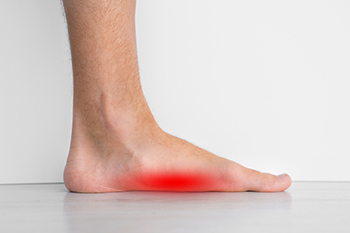What Podiatrist Do to Help Treat Flat Feet
Tuesday, 07 December 2021 00:00Some babies are born with flat feet and as they grow, the tendons in their feet tighten and formulate arches, typically by the time they reach 2 or 3 years of age. If arches never develop in babies feet, or they present only when they are sitting or on their toes, this is known as rigid flatfoot or flexible flatfoot, respectively. Flatfoot may be asymptomatic, or produce symptoms such as pain on the outside of the ankle, or achy, tired feet after playing sports or standing for extended periods of time. Calf muscles may also be tight, and there can be problems walking, standing, or balancing. If you are experiencing symptoms like these, contact a podiatrist to be diagnosed and treated properly. To determine if your condition is rigid or flexible, the podiatrist may ask you to stand on your toes. If your arch becomes visible while standing on your toes and collapses when you place your foot on the floor, you may be afflicted with flexible flatfoot. If your arch never presents (even while on your toes), the podiatrist may order a CT scan, MRI, or X-ray to make a diagnosis of rigid flatfoot. Your podiatrist may prescribe custom orthotics or special shoes to provide arch support and relieve pain, and/or calf muscle stretches to help improve ankle range of motion (dorsiflexion). If these more conservative techniques do not offer relief, surgery may be necessary to relieve pain, repair tendons, and restore the arch.
Flatfoot is a condition many people suffer from. If you have flat feet, contact Dr. Mark Spier from Maryland. Our doctor will treat your foot and ankle needs.
What Are Flat Feet?
Flatfoot is a condition in which the arch of the foot is depressed and the sole of the foot is almost completely in contact with the ground. About 20-30% of the population generally has flat feet because their arches never formed during growth.
Conditions & Problems:
Having flat feet makes it difficult to run or walk because of the stress placed on the ankles.
Alignment – The general alignment of your legs can be disrupted, because the ankles move inward which can cause major discomfort.
Knees – If you have complications with your knees, flat feet can be a contributor to arthritis in that area.
Symptoms
- Pain around the heel or arch area
- Trouble standing on the tip toe
- Swelling around the inside of the ankle
- Flat look to one or both feet
- Having your shoes feel uneven when worn
Treatment
If you are experiencing pain and stress on the foot you may weaken the posterior tibial tendon, which runs around the inside of the ankle.
If you have any questions please feel free to contact one of our offices located in Columbia and Reisterstown, MD . We offer the newest diagnostic and treatment technologies for all your foot and ankle needs.










